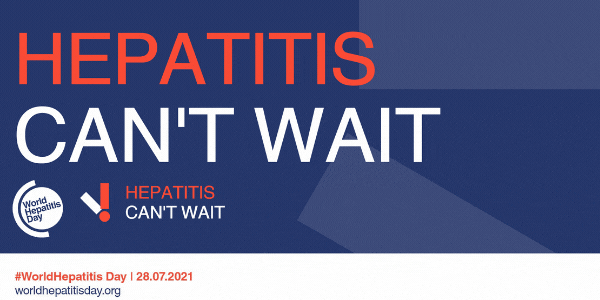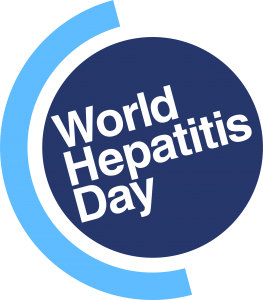EASL marks World Hepatitis Day 2021, renewing commitment to eliminating hepatitis
28 July 2021
What is World Hepatitis Day?
Every year, on 28 July, World Hepatitis Day brings the world together to focus on the theme of raising awareness about the global burden of viral hepatitis (inflammation of the liver), and to advocate for real change. World Hepatitis Day gathers us together under a single theme, which for 2021 is: Hepatitis Can’t Wait, on Twitter as#HepCantWait.
On this occasion, EASL calls on the global hepatology community to join forces with us, to take action, and raise awareness about viral hepatitis.
How does World Hepatitis Day link to the World Health Organization?
World Hepatitis Day is one of the seven global public health days officially mandated by the World Health Organization (WHO). In 2016, the WHO adopted the first Global Health Sector Strategy on Viral Hepatitis, calling for its elimination as a public health threat. The strategy presented a target for 2030 – of reducing new hepatitis infections by 90% and mortality by 65%, compared to 2015. All WHO Member States have approved this strategy. Now they have just one decade left to reach these goals and fulfil their promises.
What are the key messages of “Hepatitis Can’t Wait”?

With a person dying every 30 seconds from a hepatitis-related illness – even in the current COVID-19 crisis – we can’t wait to act on viral hepatitis.
- People living with viral hepatitis unaware can’t wait for testing
- People living with hepatitis can’t wait for life saving treatments
- Expectant mothers can’t wait for hepatitis screening and treatment
- Newborn babies can’t wait for birth dose vaccination
- People affected by hepatitis can’t wait to end stigma and discrimination
- Community organisations can’t wait for greater investment
- Decision makers can’t wait and must act now to make hepatitis elimination a reality through political will and funding.
How is EASL supporting the drive to eliminate viral hepatitis?
EASL’s mission is to be the Home of Hepatology so that everyone involved in treating patients with liver disease can realise their full potential to cure and prevent it.
We are committed to promoting public awareness of liver diseases and their management. EASL is collaborating with the WHO to combat viral hepatitis on several fronts. Read about our efforts below:
A message from Prof. Maria Buti, EASL’s EU Policy Councillor and Chair of EASL’s Policy and Public Health Committee
Hosting multi-society collaborations to share guidelines
During International Liver Congress™ 2021, at a multi-stakeholder symposium (EASL, with CDC, ECDC, and WHO), the Interim guidance for country validation of viral hepatitis C elimination was released by the World Health Organization.
Read more
This represents the first-ever global guidance for countries seeking to validate elimination of hepatitis B and/or C virus infection as a public health problem. It provides a global framework for the processes and standards for validation of elimination and proposes the use of absolute impact targets, to validate elimination at the national level in combination with a set of programmatic targets.
EASL is urging countries to provide data on new chronic viral hepatitis infections and mortality data. This is the only way to ascertain how hepatitis elimination is working in different countries.
Fostering research and development in the pipeline
The efforts to reach the WHO goal of eliminating viral hepatitis throughout Europe have been compromised by the COVID-19 crisis. EASL is strongly engaged with the elimination efforts and is conscious that there is a need to assess the impact of the crisis and to take measures accordingly. In collaboration with European Centre for Disease Prevention and Control (ECDC), EASL is currently running a survey on the impact of COVID-19 on viral hepatitis elimination, comparing the treatment of patients with viral hepatitis in 2019 vs 2020.
Hosting a dedicated event in February 2022
EASL is holding its first event dedicated to this topic, Viral Hepatitis Elimination 2022, taking place 24–25 February 2022, in Brussels, Belgium. We aim to convene all parties affected, including patients, to explore science, public health, and policy to advance the fight against viral hepatitis.
Save the date of the event: 24–25 February 2022
Contributing to country profiles, working hand in hand with CGHE
EASL is proud to be a strategic partner in the efforts of the Coalition for Global Hepatitis Elimination (CGHE) to develop national hepatitis elimination profiles for countries in Europe and beyond. These national profiles are like taking the temperature of a given country, providing an overview of its status, progress towards elimination, and steps needed to progress, listing of key stakeholders, identifying the most important initiatives and policy steps required. EASL will contribute expertise for the development of the profiles and will disseminate information about them to the global hepatology community.
To overcome the barriers to achieving viral hepatitis elimination, we must improve people’s access to screening, treatment, and care. To this end, all actors involved, including patient organisations, must work together and deliver care at the community level. In 2019, the major hepatology societies agreed that there is an urgent need to simplify viral hepatitis testing and linkage to care and today this remains a priority. Only by decentralising viral hepatitis services to local level care and task-sharing care with primary care clinicians and other health care practitioners can we achieve our goal
said Prof. Maria Buti, Professor of Medicine at the Internal Medicine and Hepatology Department, Hospital General Universitari Valle Hebron, Barcelona, and EASL’s EU Policy Councillor, and Chair of EASL’s Policy and Public Health Committee.
The EASL International Liver Foundation (EILF) continues to champion the micro-elimination approach as an integral part of every country’s efforts to eliminate hepatitis C as a public health threat by 2030, as set out by WHO. The COVID-19 pandemic has caused setbacks, so we will need to redouble our efforts in pursuit of the 2030 goals. EILF remains a staunch ally to our partners around the world, aiming to ensure viral hepatitis receives the attention it deserves. We confirm our ongoing support of elimination efforts taking place globally,
said Prof. Jeff Lazarus, EASL Policy and Public Health Committee Member, and Vice-Chair of the EASL International Liver Foundation.
Research recently published in the Journal of Hepatology
- “Global burden of acute viral hepatitis and its association with socioeconomic development status, 1990–2019” published open access 4 May 2021, by Dan-Yi Zeng, et al.
- “Impact of direct-acting antivirals for HCV on mortality in a large population-based cohort study” published 4 June 2021, by Naveed Z. Janjua, et al.
Other EASL efforts to date, tools, and resources
EASL is engaged in fighting liver diseases on many fronts, drawing upon the power of the hepatology network worldwide. Year by year, we are proud to be developing new initiatives and publications for clinicians, policymakers, and patients.
- Clinical Practice Guidelines, updated and released in September 2020 by the Journal of Hepatology: EASL recommendations on treatment of hepatitis C: Final update of the series, with accompanying webinar and slide decks
- Policy statement on drug use and the global hepatitis C elimination goal released in August 2020, available in full and in lay-summary format; translated into four more languages: Czech, French, German, and Russian
- Policy statement: Eliminating Hepatitis C – an Action Plan, translated into 11 languages; available in full and lay-summary format
Focusing on hepatitis C and treating it
Together, hepatitis B (HBV) and HCV cause vast numbers of deaths. An estimated 71 million people worldwide live with chronic HCV, up to 14 million of them in Europe. A significant proportion of them will develop cirrhosis or liver cancer. As many as 400,000 people die per year globally of HCV. Currently, there is no effective vaccine against HCV. But there are antiviral medicines, known as directly acting antivirals (DAAs), that can cure more than 95% of these people and reduce dramatically their chances of long-term complications, like liver failure and hepatocellular carcinoma. These medicines are a medical revolution and offer hope to many. But to access them, people need improved awareness and rapid testing, offering them both a path to early diagnosis and access to affordable treatment.
Read more
Who is most likely to contract HCV?
Because HCV is bloodborne, it is mostly spread by exposure to blood or blood products. People who are particularly vulnerable include: those who inject drugs, men who have sex with men (in high-risk sexual practices), prisoners, sex workers, and migrants from countries with HCV high prevalence due to unsafe injection practices. Because many of them are subjected to stigma and its related challenges, they may need extra support to access treatment.
Working together to eliminate Viral Hepatitis by 2030







